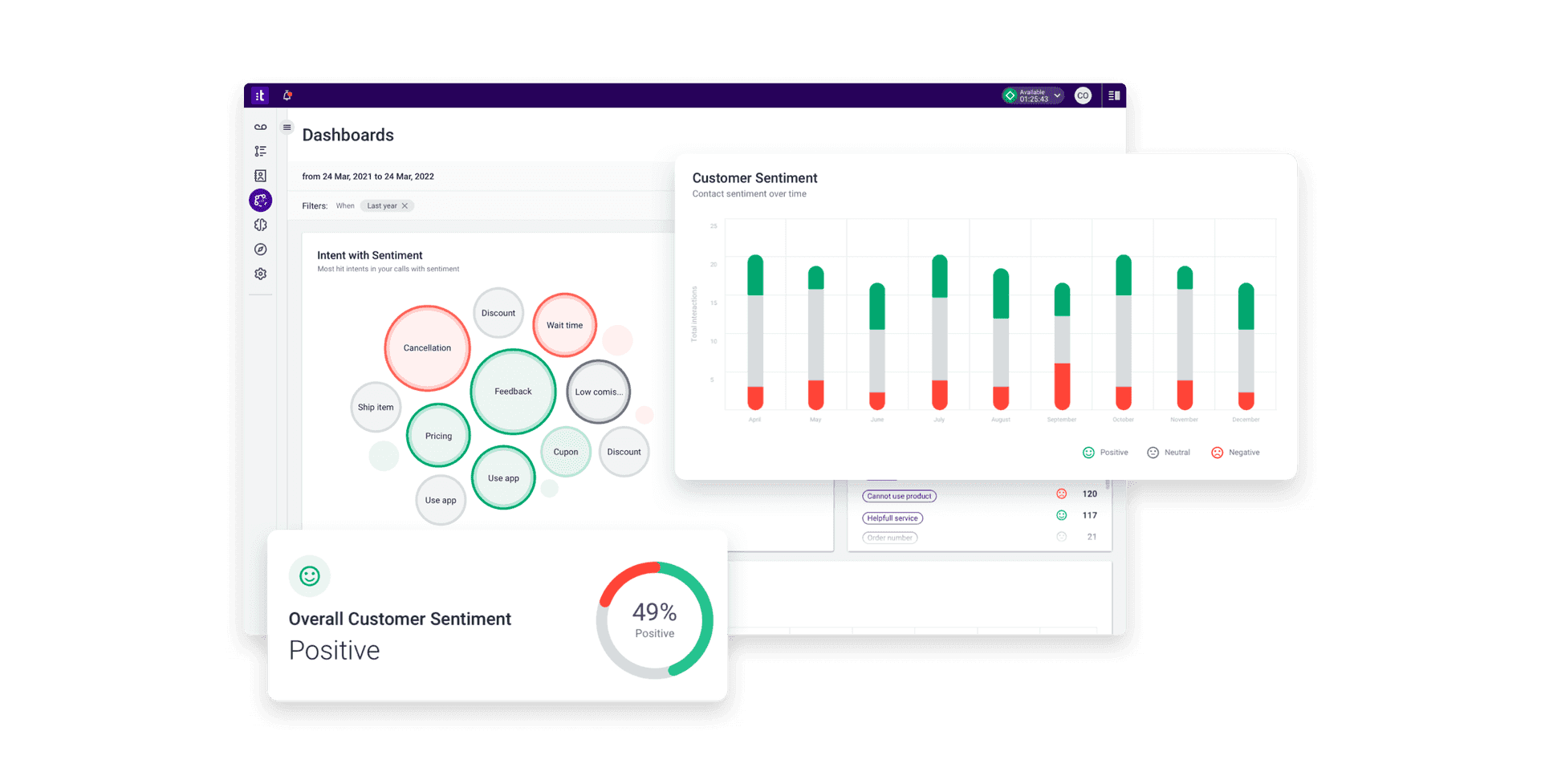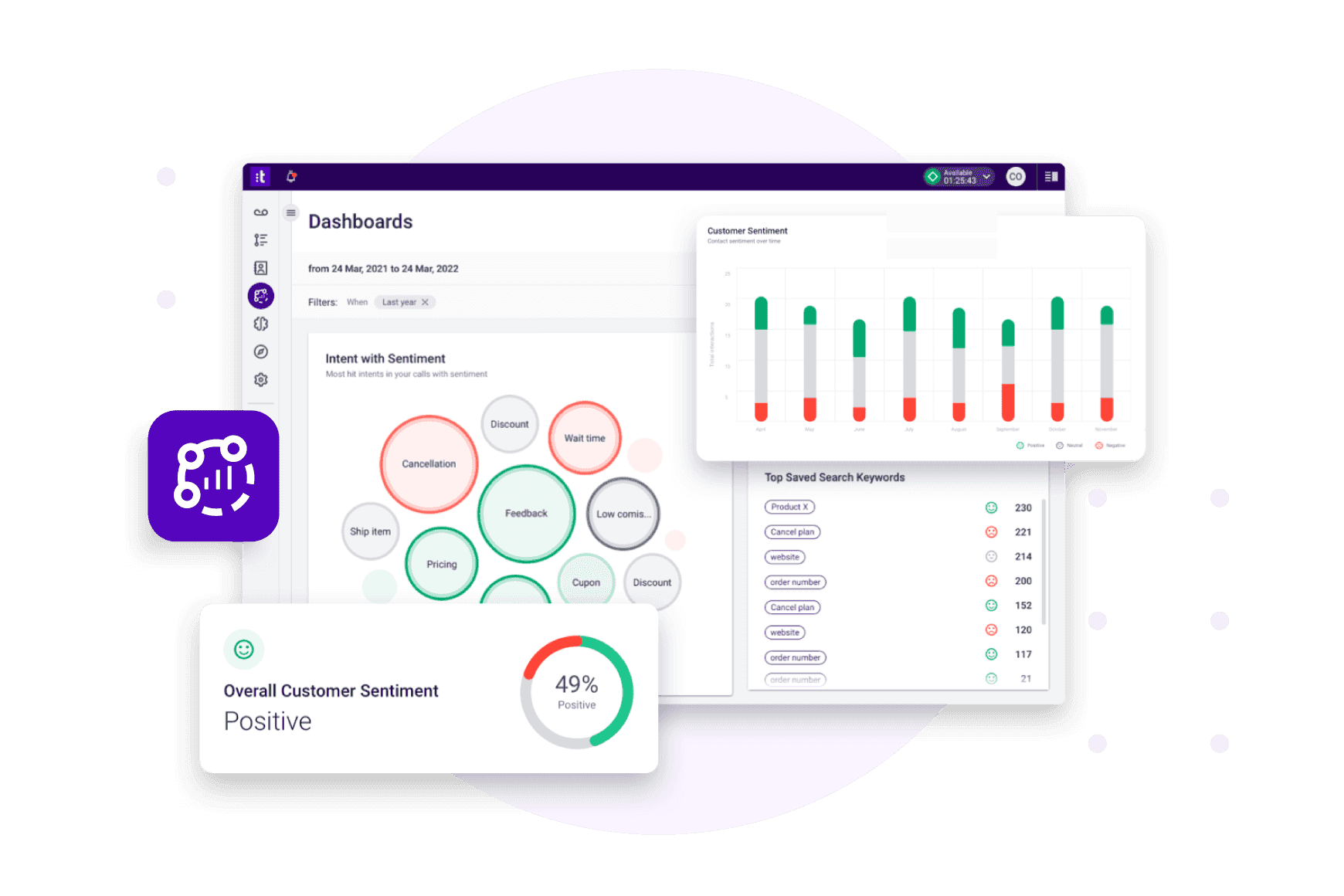What is sentiment analysis, and how can it improve customer experience?

By Kevin McNulty
0 min read

From Twitter/X rants to product reviews to customer support interactions, sentiment analysis can extract invaluable customer insights from a multitude of data sources and inject precision into your marketing, sales, and support strategies. At the intersection of linguistics and artificial intelligence (AI), sentiment analysis allows brands to tap into the emotions, opinions, and attitudes of their customers.
Using natural language processing (NLP) techniques and machine learning algorithms, sentiment analysis can determine the emotional tone of textual data and make predictions based on patterns and context. There are a wide range of business applications, including customer feedback analysis, reputation management, and product development, making it an essential tool for decision-making and meeting customer expectations in today’s digital marketplace.
This guide will cover:
- How customer sentiment analysis improves CX.
- How customer sentiment analysis works.
- Places to analyze customer sentiment.
- Sentiment analysis tools you can use to improve CX.
How does customer sentiment analysis improve CX?
1. Deliver data-driven experiences.
Use customer sentiment analysis to get customer feedback about a specific issue. Here are some of the scenarios in which you might benefit from sentiment analysis:
-
You may find that the reason for customers being unsatisfied with your service is due to a long problem resolution time and focus on improving contact center metrics, such as average speed of answer or average handle time (AHT).
-
With the support of an AI-powered virtual assistant, you can also receive insights into the customer’s emotions during a conversation and handle the call more efficiently.
-
Access to the customer’s historical data and information from previous interactions allows you to provide a better and more personalized experience. Knowing exactly the customer’s pain points helps you solve their problems in a more agile and rapid manner. It also allows you to proactively reach out to customers—through phone calls, email, or voice and chatbots—with relevant information.
2. Improve products and services.
Understanding exactly what your customers need the most is a great way to determine which feature you should add to your product or service. You can use customer comments about missing features to give them exactly what they need. You can also use this information to detect issues and bugs.
-
Say you run a software company and your product is a project management tool. You receive feedback from users saying they are having trouble with the task assignment feature. With sentiment analysis, you can identify this common thread and prioritize improvements of this feature.
3. Optimize the marketing strategy.
Customer insights are what drive marketing strategies. Marketing teams can keep an eye on market trends while analyzing what customers say about your brand. Knowing the customer’s opinions about a specific product or feature can highlight opportunities for new marketing campaigns. It can also be particularly useful for marketing teams to see what customers are saying about their competitors.
-
If you have a number of products, sentiment analysis helps you understand which of your products are most loved by your customers, based on their comments and reviews. This insight can guide your marketing strategy, allowing you to promote popular products more aggressively or highlight underappreciated features. It also provides valuable information about how customers perceive your competitors.
4. Monitor brand reputation.
It’s important to know what your customers are saying about your brand. With sentiment analysis, you can monitor brand mentions in real time—for example, on websites, app stores, and social media—and address negative comments before they spiral into a bigger problem.
-
If you already have a strong online presence, using sentiment analysis, you can monitor real-time mentions of your brand across various platforms, identifying whether the sentiment is positive, negative, or neutral. If there’s a sudden increase in negative comments, you can quickly intervene to address the concerns, preventing a minor issue from escalating into a major blow to your reputation.
How does customer sentiment analysis work?
Customer sentiment analysis is an automated process that analyzes interactions between your customers and your brand to discover the emotions they feel about a product, service, or the brand as a whole. Using AI, NLP, and other machine learning algorithms sentiment analysis models detect patterns in voice (from transcription) or text and classify customer emotions in three or more different categories—positive, negative, neutral, or more fine-grained. Here are some of the different types of sentiment analysis:
Standard sentiment analysis.
The most common process for sentiment analysis. It uses AI and NLP to extract a positive, negative, or neutral sentiment from unstructured data in support tickets, phone calls, survey and feedback forms, social media comments, voice (from transcription) and chatbots, and other channels. It analyzes specific words that might lead to a sentiment such as “love”, “hate”, “good”, and others to classify the emotions.
Fine-grained sentiment analysis.
A more concrete type of sentiment analysis—it analyzes the customers’ emotions more closely and precisely than the standard sentiment analysis. These emotions can be classified as very positive, positive, neutral, negative, or very negative.
Emotion detection.
Often associated with customer feedback of frustration, anger, happiness, and other emotions. The main difference between this and other types of sentiment analysis is that it focuses on things, such as tone and punctuation to differentiate specific emotions. For example, the sentence “This product was unbelievable!” might have a different connotation from “This product was unbelievable”.
Intent analysis.
The main purpose of intent sentiment analysis is to identify the action or opportunity for improvement from customer feedback. For example, analyzing sentences such as “this feature is not working”, “I’m not able to”, or “you should help me with this” allows you to easily target customer issues and make smarter decisions.

EBOOK
ChatGPT and the contact center of the future
Find out how this exciting new technology will change everything from conversational AI to the role of the contact center agent.
Four places to analyze customer sentiment.
Now that you have a clear idea of how customer sentiment works and how to analyze it, you might be wondering where to find the information that brings more value to your customer sentiment analysis. Here are four areas in which you can collect insightful customer sentiment analytics.
1. Contact center.
You already know that your contact center is a great source of customer data, but do you know how much it can do for your customer sentiment analysis? Your contact center is one of the main points of interaction between you and your customers. AI-powered tools can, during a simple conversation, analyze the tone and sentiment of the customer, which can be particularly useful during stressful situations or more complex issues. If you know how your customers feel, you are able to provide them with the appropriate response. Besides phone calls, you can also use tools, such as chat and voice bots, to analyze customer sentiment and intent and provide the most personalized automated response.
Talkdesk Interaction Analytics™ is an AI-powered speech and text analytics tool that captures, transcribes, and analyzes every customer interaction across all contact channels. It supports your contact center agents by finding key customer intents and sentiments and suggesting the next best action.

2. Social media.
Customer sentiment from social media can come from a comment on a post, a review on a social media page, or even direct messages. With all these different types of interactions, social media has become one of the most common sources for collecting customer feedback.
3. Reviews.
Reviews are a great place to collect customer sentiment insights. Usually, people who write a review on the company’s website or a website specially dedicated to reviews, for example, are committed to letting everyone know exactly how they feel about a product or service. You can boost these reviews by adding a simple form in your company newsletter or on follow-up communications with questions, such as “Would you recommend this product?” or “How would you describe your experience with this product”. You can even incentivize customers to give a review on your service with a discount or additional benefits on their purchase/use of the service.
4. Surveys.
Surveys are great tools to connect with customers directly and get accurate feedback. Deliver customer surveys with questions, such as “How was your experience with us?”, “How was your experience compared to your expectations?”, “What would you change in our product or service?”, and use automated text analysis to make the best out of customer responses. Avoid closed-end “yes or no” questions and bet more on open questions that can motivate your customers to say how they truly feel about your service, product, or brand as a whole.
What are sentiment analysis tools?
Sentiment analysis tools are software or programs that help businesses understand the emotions and opinions expressed in textual and unstructured voice data. In contact centers, these can be used to analyze customer interactions and feedback. For example:
- Text analytics software. This type of software can analyze written feedback from emails, chat transcripts, or social media posts to determine the sentiment.
- Speech analytics tools. These can analyze spoken words from recorded calls to understand customer sentiment.
- AI chatbots. These can analyze sentiment during live chats, helping agents adjust their approach in real time based on the customer’s mood.
- Social media monitoring tools. These tools can track mentions of a company or product on social media and analyze the sentiment of those comments.
These tools help contact centers gauge customer satisfaction and identify areas for improvement in real time.
Analyze customer sentiment for better CX with Talkdesk Interaction Analytics.
Customer sentiment is one of the most important metrics for your business—and for your CX strategy. Track it to know exactly how customers feel about your company, product, or service and use that knowledge to improve. You’ll know what to adjust if you find the majority of your customers struggling with a particular aspect or step of your product or service; you’ll get useful insights on what you are doing right—and should keep pursuing.
The right technology enables you to improve the relationship with your customers, turning them into brand advocates. Talkdesk Interaction Analytics is an AI-powered speech and text analytics tool that captures, transcribes, and analyzes every customer interaction across all contact channels. Find key conversational moments, topics, customer intents, and sentiments to take the next best action to create a more frictionless CX. Learn more or request a demo today!

DEMO
Get Talkdesk Interaction Analytics
Interaction Analytics helps you customer sentiment and discover better ways to create the best customer journey to improve CSAT and drive more revenue.
FAQs.
What is sentiment analysis?
Sentiment analysis, or opinion mining, is a method used to identify and interpret subjective information from various sources. It involves using natural language processing, text analysis, and computational linguistics to determine the attitudes, emotions, and opinions underlying a text or voice recording. It is particularly valuable in understanding customer sentiments regarding a particular product or service.
What is customer sentiment?
Customer sentiment is a key performance indicator (KPI) that shows customers’ emotions towards a product, service, or brand. It shares some similarities with other KPIs, such as customer satisfaction (CSAT) and Net Promoter Score (NPS), but instead of being a quantitative measure, customer sentiment is a qualitative, crucial metric. It is connected to nearly every other KPI— if customers are unhappy with your brand and service, chances are CSAT is low, and you can use customer sentiment to understand why.
When customers engage with your brand—by using a product and leaving a review online, interacting through phone calls and voice and chatbots, talking about your company on social media, or others—there’s always a predominant emotion involved.
Knowing how customers feel about your brand is one of the keys to business success. Sentiment analysis helps to understand what works best—and should be kept—and what needs to be improved to suit the needs of your customers. With sentiment analysis, you can collect information about customers’ feelings and opinions on your brand or product and use it to make smarter decisions to improve customer satisfaction and loyalty.
What is an example of sentiment analysis?
An example of sentiment analysis is analyzing customer reviews of a product. For instance, if a company launches a new smartphone, it could use sentiment analysis to scan online reviews and social media comments about the product. This process can help them understand if customers generally feel positive, negative, or neutral about the new phone, and what specific features they like or dislike.








